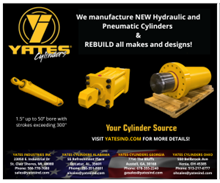Commercial Metals Reports First Quarter Loss
12/24/2009 - Commercial Metals reports a net loss of $31.2 million ($0.28 per share) on net sales of $1.4 billion for the quarter ended November 30, 2009, compared with net earnings of $62.0 million ($0.54 per diluted share) on net sales of $2.4 billion for last year's first quarter.
Commercial Metals Co. has reported a net loss of $31.2 million ($0.28 per share) on net sales of $1.4 billion for the quarter ended November 30, 2009, compared with net earnings of $62.0 million ($0.54 per diluted share) on net sales of $2.4 billion for the first quarter of last year.
Results included pre-tax LIFO income of $17.3 million or after tax $0.10 per share; last year's first quarter pre-tax LIFO income was $114 million or after tax $0.65 per diluted share. At quarter end, the LIFO reserve totaled $224 million.
The company recorded the following consolidated expenses during the first quarter:
▪ Lower of cost or market inventory adjustments — $12.9 million
▪ Bad debt expense — ($2.5) million
▪ Severance costs — $2.2 million
▪ Other contractual noncompliance and job loss reserves — 7.4 million
"In a period of uneven global economic recovery, our end-use markets ranged from weak to improving,” said Murray R. McClean, Chairman, President and CEO. “We believe the worst of the economic crisis is behind us, yet the prospects for better days will be delayed by the traditionally weak winter season encompassing our second quarter. Real sustainable domestic increases in demand were not apparent and there was no discernable stimulus effect.
“Internationally, Asian and Pacific economies showed strength; China continued to sustain impressive GDP growth along with its Asian neighbors,” McClean continued. “Australia's economy was in full recovery, evidenced by its central bank raising interest rates during the quarter. Poland achieved volume, but at low metal margins. Our tubular mill in Croatia is reducing its losses and moving forward with its melt shop improvements.
“Domestically, scrap prices were dictated by the volume of export activity. Commercial markets were extremely weak, leaving fierce competition for available markets predominantly in public sector work. This resulted in deteriorating metal margins at both our mills and fabrication units. Industrial products remained profitable as did our copper tube mill, and our micro mill in Arizona is ramping up on schedule," said McClean.
Americas Mills—"Though volumes increased 13% over the first quarter of last year, metal margins were down and our product mix was not favorable,” McClean said. “The increase in tonnage was predominantly in billet sales, which allowed our melt shops to run at 74% of capacity, but left our mills at only 54% of capacity, down significantly from 68% in the fourth quarter. Average sales prices fell faster than ferrous scrap prices, resulting in metal margin contraction; imported material remained low.”
(For purposes of comparability and due to the startup phase of its mill in Arizona, references to tons and sales prices omit results of CMC Arizona.)
"After absorbing startup costs of $11.3 million at the new micro mill in Arizona, our steel mills had adjusted operating loss of $5.0 million compared to $101.3 million operating profit in the same quarter last year; this year's first quarter had pre-tax LIFO expense of $0.6 million compared to $66.5 million LIFO income in last year's first quarter,” he said. “Our metal margin at $251 per ton was down $209 per ton from the first quarter of last year and sequentially deteriorated $51 per ton from the fourth quarter of last year. The price of ferrous scrap consumed at the mills during the quarter fell $70 per ton compared to last year's first quarter, but our average selling price for all sales of $517 per ton fell $279 per ton. Not considering billet sales, the average price fell $256 per ton. Sales volumes increased 13% to 490 thousand tons of which 117 thousand tons were billets (compared with 39 thousand tons of billets sold in the first quarter of last year). Rebar accounted for 46% of finished goods tonnage shipped in the first quarter. The price premium of merchant bar over reinforcing bar averaged $173 per ton, down $20 per ton sequentially from the fourth quarter of last year. On a first quarter-to-quarter basis, tonnage melted was up 17% to 465 thousand tons, while tonnage rolled declined 7% (effect of additional billet sales) to 341 thousand tons."
McClean noted that the company’s new micromill, CMC Steel Arizona, continued to perform to expectations in its ramp-up phase. The first heat was tapped on September 8. The micromill melted and rolled 14 thousand tons during the quarter, and shipped 8 thousand tons.
"Our copper tube mill continued to follow its successful business model as it reported an adjusted operating profit of $3.4 million (including pre-tax LIFO expense of $3.0 million) compared to $17.4 million (including pre-tax LIFO income of $8.7 million) in the first quarter of last year,” he said. “Metal margins of $1.39 per pound in the quarter were down 3% from the prior year."
International Mills—"European markets showed little signs of recovery,” McClean said. “Though volumes were up substantially at CMC Zawiercie, metal margins were at unacceptable levels. CMC Croatia's cost containment initiatives lowered its losses, even in the face of weak sales volumes. The segment had an adjusted operating loss of $18.9 million in the first quarter compared to a $16.7 million loss for the same period last year.
"CMC Zawiercie's adjusted operating loss of $11.4 million continued a distressing trend of strong volumes combined with compressed metal margins turning into significant losses; last year's loss was $8.1 million,” McClean continued. “Competition was keen and the Polish scrap market remained fractured. Shipments totaled 355 thousand tons (103 thousand tons of billets) compared to 295 thousand tons (35 thousand tons of billets) in the prior year first quarter. Tons melted were 399 thousand tons compared to 290 thousand tons last year, and tons rolled were 266 thousand tons compared to 237 thousand tons in the prior year first quarter. Average selling prices declined 29% to PLN 1,220 per ton compared to PLN 1,714 per ton for the same period last year. The cost of scrap entering production decreased 17%. The average metal margin decreased to PLN 438, 43% below last year's first quarter, and 3% below the fourth quarter of last year.
"CMC Croatia's adjusted operating loss of $7.5 million was encouraging only in the fact that it was lower than any quarterly loss of fiscal 2009. The operation has been focused on lowering melt costs, concentration on seamless pipe, lowering its cost structure, and opening new markets. Finished goods pricing appears to have bottomed during the quarter. The mill shipped 9 thousand tons during the quarter."
Financial Condition—"We retain our conservative posture during what we believe are the latter stages of the economic crisis,” said McClean. “At November 30, 2009, we had cash and short-term investments of $334 million. Significant portions of our accounts receivable continue to be backed by letters of credit or are credit insured; the allowance for doubtful accounts remains near its historic high. Substantially all of our domestic inventories are on LIFO; the reserve at quarter end was $224 million. Goodwill and intangibles comprise only 3.8% of our total assets.
"During the quarter we renewed the $400 million revolving credit agreement that backs our commercial paper program extending the maturity date to November 24, 2012,” he continued. “We also extended our existing $100 million A/R securitization agreement to November 24, 2010. Both agreements require an interest coverage ratio on a twelve-month rolling basis of not less than 1.5 as reported each fiscal quarter end up to and including May 31, 2010; thereafter the required ratio is 2.5. The agreements also require us to maintain liquidity of at least $300 million in cash, investments, and A/R securitization capacity combined, and to maintain a debt to capitalization ratio less than 60%. At November 30, 2009, we were in compliance with all covenants."
Outlook—"As previously disclosed, effective December 1, 2009, the company reorganized certain business operations. The most significant change was moving our domestic steel import and distribution business to International Marketing and Distribution, once again combining all our marketing operations into one segment,” McClean said.
"Domestic ferrous scrap prices, which historically rise in the latter months of the winter in anticipation of the spring construction season, are already on the increase driven by export demand and some signs of U.S. economic stabilization, if not recovery. Domestic stimulus programs may finally be evidenced by spring. Coupled with an improving economy, the second half of our fiscal year appears more promising, though we believe at modest levels. Private nonresidential construction is likely to remain weak. Import competition is also likely to be weak."
McClean added, "China will be the catalyst in calendar 2010 with anticipated GDP growth between 9 to 10% and greater steel demand than in 2009; this most likely will exert upward pressure on both iron ore and scrap prices. The rest of Asia should follow China with anticipation of strong demand for scrap and billet export opportunities to the region. Australia should continue what is developing as a strong recovery. Polish volumes should reflect the seasonal downturn.
"We are in for one more challenging quarter as we enter the winter season and domestic recovery signs point to early spring,” McClean said. “The recent climb in ferrous scrap prices should allow our recycling operations to be profitable; this will cause a short-term margin squeeze at the domestic mills which, in any case, will be absorbing more startup expenses at CMC Steel Arizona. The winter seasonal downturn should see our mills operating at between 55 and 60%. Domestic fab will be hit hardest as competition lowers average selling prices and rising scrap prices raise input costs. Internationally, winter will adversely affect Poland, but we anticipate that Croatia will continue its improvement trend. Overall, we anticipate second quarter results, barring significant LIFO swings, to be similar to that of the first quarter.
"The second quarter is historically our weakest,” McClean continued. “Our projection of the results for that quarter is based on the best information available, but is subject to variation as discussed in the section on forward-looking statements, particularly the level of global economic recovery. Effects of these factors will be reflected in various accounts including inventories valued on LIFO, market to market adjustments on other inventories, reserves for future job losses, the level of allowance for doubtful accounts, and the amount of interest capitalized on capital projects.
“As any of these factors may be significant, and with the volatility of metal prices that may swing in either direction, our ability to meet the EBITDA to interest compliance covenant, which is part of our revolving credit and A/R securitization agreements, at the end of the second quarter is not assured. Both of these agreements are used as alternative sources of liquidity, but neither has been used since January 2009, nor is expected to be used during the second quarter. The company's public debt does not have these covenants. The company believes it will either meet the covenant test or successfully negotiate an amendment to the agreements that will provide for a covenant test that the company will meet,” McClean concluded.
Commercial Metals Co. and subsidiaries manufacture, recycle, and market steel and metal products, related materials, and services through a network including steel minimills, steel fabrication and processing plants, construction-related product warehouses, a copper tube mill, metal recycling facilities, and marketing and distribution offices in the United States and in strategic international markets.



.jpg?lang=en-US&ext=.jpg)
.gif?width=220&height=200&mediaprotectionhash=374c6b9a31f2b2fbfc7937391034efb46fd57feba997b9ad2ae9a0bd3d48329d&ext=.gif)

.gif?width=100&height=200&mediaprotectionhash=e2d5b15d68f84f22038524be6c58e5268d67b7f44494b544e29a8d53c5b959ba&ext=.gif)
